- Regulatory Status
- RUO
- Other Names
- Tumor necrosis factor ligand superfamily, member 11 (TNFSF11), Osteoprotegerin ligand (OPGL), Receptor activator of NF-kappa-B ligand (RANKL), TNF-related activation-induced cytokine (TRANCE), Osteoclast differentiation factor (ODF), CD254.
- Ave. Rating
- Submit a Review
- Product Citations
- publications
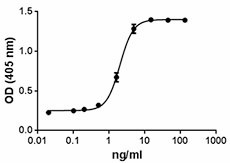
-

Human RANKL induces osteoclast differentiation in RAW264.7 cells.
Human TRANCE gene, also known as RANKL, encodes a type II membrane protein of 317 amino acids with a predicted molecular mass of 35.4 kD. RANKL is cleaved to produce a soluble form with biological activity. The shedding of membrane-bound RANKL appears to be mediated by expression of matrix metalloproteinase 14 (MMP14) and ADAM10. Suppression of MMP14 in primary osteoblasts increased membrane-bound RANKL and promoted osteoclastogenesis in cocultures with macrophages. Therefore, RANKL shedding seems to be an important process that downregulates local osteoclastogenesis. Conversely, increased production of RANKL by osteoblastic cells leads to osteoclast differentiation, activation, and survival, which results in increased bone resorption. Binding of RANKL to its receptor RANK activates TNF receptor-associated factor 6 (TRAF6), which is linked to downstream pathways including NF-κB, c-jun N-terminal kinase (JNK), and Src. TRAF6 in particular has been shown to be necessary for the differentiation of osteoclastic cells by enhancing Src kinase, essential for osteoclast function. Activation of JNK and NF-κB by RANKL induces the expression of IL-1, IL-6, IL-12, and IL-15 in dendritic cells. In addition, RANKL stimulates proliferation, adhesion, and IL-7 expression of thymic epithelial cells. RANKL can mediate bone loss in arthritis and periodontal disease.
Product DetailsProduct Details
- Source
- Human TRANCE, amino acids 9His-SGGGSGGG-IEGR-(Gly64-Asp245) (Accession# AF013171) was expressed in 293E cells.
- Molecular Mass
- The 203 amino acid recombinant protein has a predicted molecular mass of approximately 22.7 kD. The DTT-reduced and non-reduced protein migrate at approximately 36-40 kD by SDS-PAGE. The N-terminal amino acid is His.
- Purity
- >95%, as determined by Coomassie stained SDS-PAGE.
- Formulation
- 0.22 µm filtered protein solution is in 10mM NaH2PO4, 0.3M NaCl buffer, pH 6.0
- Endotoxin Level
- Less than 0.01 ng per µg cytokine as determined by the LAL method.
- Concentration
- 10 and 25 µg sizes are bottled at 200 µg/mL. 100 µg size and larger sizes are lot-specific and bottled at the concentration indicated on the vial. To obtain lot-specific concentration and expiration, please enter the lot number in our Certificate of Analysis online tool.
- Storage & Handling
- Unopened vial can be stored between 2°C and 8°C for up to 2 weeks, at -20°C for up to six months, or at -70°C or colder until the expiration date. For maximum results, quick spin vial prior to opening. The protein can be aliquoted and stored at -20°C or colder. Stock solutions can also be prepared at 50 - 100 µg/mL in appropriate sterile buffer, carrier protein such as 0.2 - 1% BSA or HSA can be added when preparing the stock solution. Aliquots can be stored between 2°C and 8°C for up to one week and stored at -20°C or colder for up to 3 months. Avoid repeated freeze/thaw cycles.
- Activity
- Bioactivity was measured by its property to induce osteoclast differentiation in RAW264.7 cells in the presence of 2.5 µg/ml of anti-His tag antibody (Cat. No. 652507). The ED50 = 0.75 - 4.5 ng/ml.
- Application
-
Bioassay
- Application Notes
-
BioLegend carrier-free recombinant proteins provided in liquid format are shipped on blue-ice. Our comparison testing data indicates that when handled and stored as recommended, the liquid format has equal or better stability and shelf-life compared to commercially available lyophilized proteins after reconstitution. Our liquid proteins are verified in-house to maintain activity after shipping on blue ice and are backed by our 100% satisfaction guarantee. If you have any concerns, contact us at tech@biolegend.com.
Antigen Details
- Distribution
-
T cells, osteoblasts, bone marrow stromal cells, hypertrophic and prehypertrophic chondrocytes, stromal fibroblasts, synovial cells, mammary gland epithelial cells, and megakaryocytes.
- Function
- RANKL induces osteoclast formation, bone-resorbing activity in mature osteoclasts, lymphocyte development, and lymph node organogenesis. RANKL augments the ability of dendritic cells to stimulate naive T-cell proliferation and dendritic cell survival. RANKL expression is stimulated by various cytokines (IL-1, TNFα and IL-11) and calciotrophic hormones including PTH, 1,25dihydroxyvitamin D3 (1,25D3) and prostaglandin E2.
- Interaction
- T cells, dendritic cells, bone marrow derived macrophages, osteoclast precursors and mature osteoclasts.
- Ligand/Receptor
- TNFRSF11A (Tumor necrosis factor receptor superfamily, member 11A) also called RANK and TNFRSF11B (OPG) which acts as a decoy receptor for RANKL.
- Cell Type
- Embryonic Stem Cells
- Biology Area
- Cell Biology, Signal Transduction, Stem Cells
- Molecular Family
- Cytokines/Chemokines, Growth Factors
- Antigen References
-
1. Dehm SM, et al. 2004. Biochem. Cell Biol. 82:263.
2. Hikita A, et al. 2006. J. Biol. Chem. 281:36846.
3. Kim NS, et al. 2006. Mol. Cell Biol. 26:1002.
4. Wada T, et al. 2006. TRENDS Mol. Med. 12:17.
5. Lee HW, et al. 2008. Exp. Mol. Med. 40:59.
6. Ha J, et al. 2010. J. Immunol. 184:4717.
7. Hasturk H, et al. 2012. Front Immunol. 3:118.
8. Tanaka S. 2013. World J. Orthop. 4:1. - Gene ID
- 8600 View all products for this Gene ID
- UniProt
- View information about TRANCE on UniProt.org
Related FAQs
- Why choose BioLegend recombinant proteins?
-
• Each lot of product is quality-tested for bioactivity as indicated on the data sheet.
• Greater than 95% Purity or higher, tested on every lot of product.
• 100% Satisfaction Guarantee for quality performance, stability, and consistency.
• Ready-to-use liquid format saves time and reduces challenges associated with reconstitution.
• Bulk and customization available. Contact us.
• Learn more about our Recombinant Proteins. - How does the activity of your recombinant proteins compare to competitors?
-
We quality control each and every lot of recombinant protein. Not only do we check its bioactivity, but we also compare it against other commercially available recombinant proteins. We make sure each recombinant protein’s activity is at least as good as or better than the competition’s. In order to provide you with the best possible product, we ensure that our testing process is rigorous and thorough. If you’re curious and eager to make the switch to BioLegend recombinants, contact your sales representative today!
- What is the specific activity or ED50 of my recombinant protein?
-
The specific activity range of the protein is indicated on the product datasheets. Because the exact activity values on a per unit basis can largely fluctuate depending on a number of factors, including the nature of the assay, cell density, age of cells/passage number, culture media used, and end user technique, the specific activity is best defined as a range and we guarantee the specific activity of all our lots will be within the range indicated on the datasheet. Please note this only applies to recombinants labeled for use in bioassays. ELISA standard recombinant proteins are not recommended for bioassay usage as they are not tested for these applications.
- Have your recombinants been tested for stability?
-
Our testing shows that the recombinant proteins are able to withstand room temperature for a week without losing activity. In addition the recombinant proteins were also found to withstand four cycles of freeze and thaw without losing activity.
- Does specific activity of a recombinant protein vary between lots?
-
Specific activity will vary for each lot and for the type of experiment that is done to validate it, but all passed lots will have activity within the established ED50 range for the product and we guarantee that our products will have lot-to-lot consistency. Please conduct an experiment-specific validation to find the optimal ED50 for your system.
- How do you convert activity as an ED50 in ng/ml to a specific activity in Units/mg?
-
Use formula Specific activity (Units/mg) = 10^6/ ED50 (ng/mL)
 Login / Register
Login / Register 







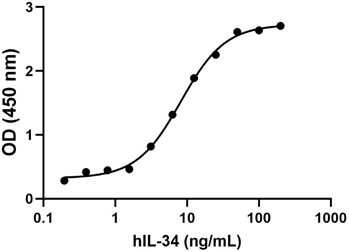
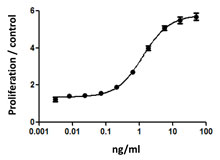
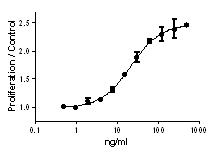
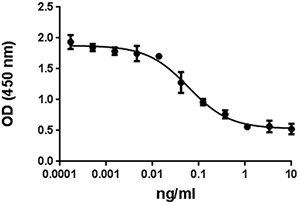



Follow Us